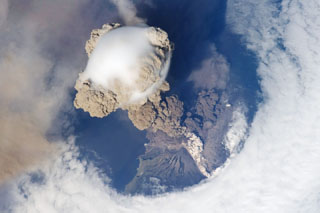Report on Sarychev Peak (Russia) — 22 July-28 July 2009
Smithsonian Institution / US Geological Survey
Weekly Volcanic Activity Report, 22 July-28 July 2009
Managing Editor: Sally Sennert.
Please cite this report as:
Global Volcanism Program, 2009. Report on Sarychev Peak (Russia) (Sennert, S, ed.). Weekly Volcanic Activity Report, 22 July-28 July 2009. Smithsonian Institution and US Geological Survey.
Sarychev Peak
Russia
48.092°N, 153.2°E; summit elev. 1496 m
All times are local (unless otherwise noted)
Based on analyses of satellite imagery, SVERT reported that on 22 July a gas-and-steam plume from Sarychev Peak drifted 35 km N. Cloud cover prevented observations during 23-26 July. On 27 July, a steam-and-gas plume possibly containing some ash rose to an altitude of 3.7 km (12,000 ft) a.s.l. and drifted 55 km NW.
Geological Summary. Sarychev Peak, one of the most active volcanoes of the Kuril Islands, occupies the NW end of Matua Island in the central Kuriles. The andesitic central cone was constructed within a 3-3.5-km-wide caldera, whose rim is exposed only on the SW side. A dramatic 250-m-wide, very steep-walled crater with a jagged rim caps the volcano. The substantially higher SE rim forms the 1496 m high point of the island. Fresh-looking lava flows, prior to activity in 2009, had descended in all directions, often forming capes along the coast. Much of the lower-angle outer flanks of the volcano are overlain by pyroclastic-flow deposits. Eruptions have been recorded since the 1760s and include both quiet lava effusion and violent explosions. Large eruptions in 1946 and 2009 produced pyroclastic flows that reached the sea.
Sources: Tokyo Volcanic Ash Advisory Center (VAAC), Sakhalin Volcanic Eruption Response Team (SVERT)

